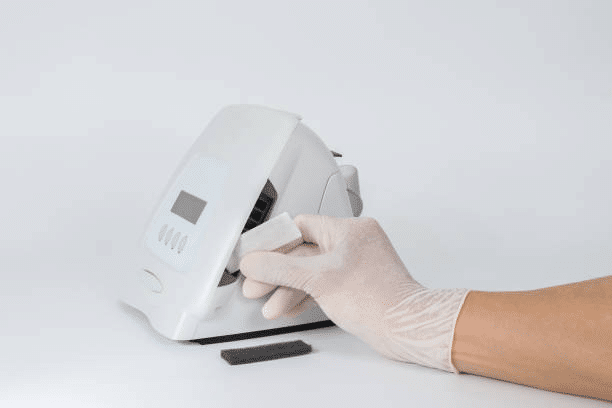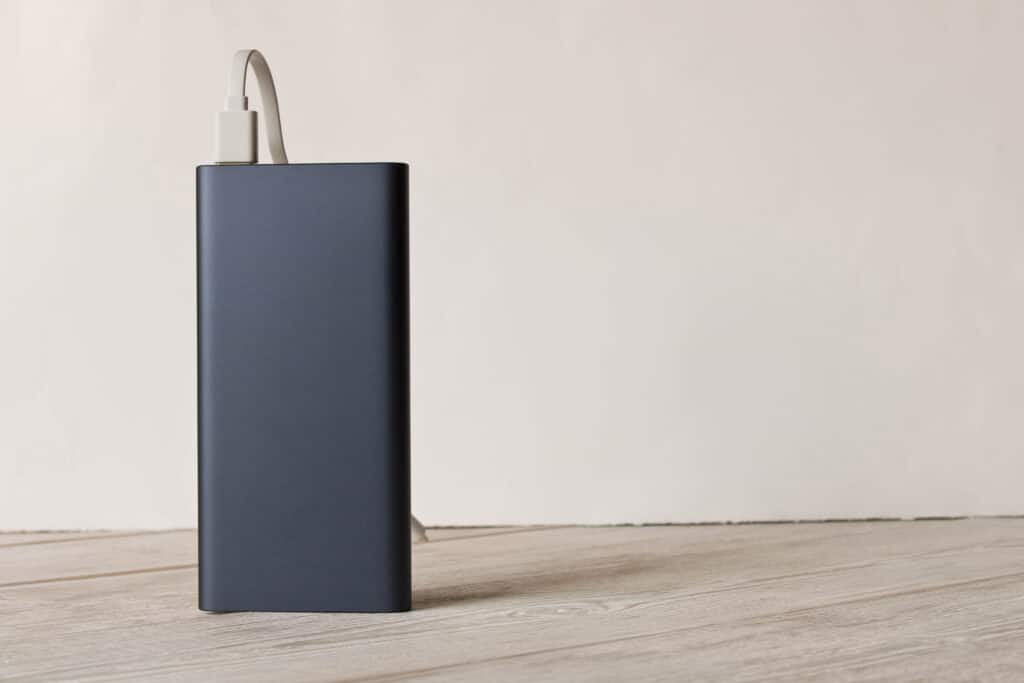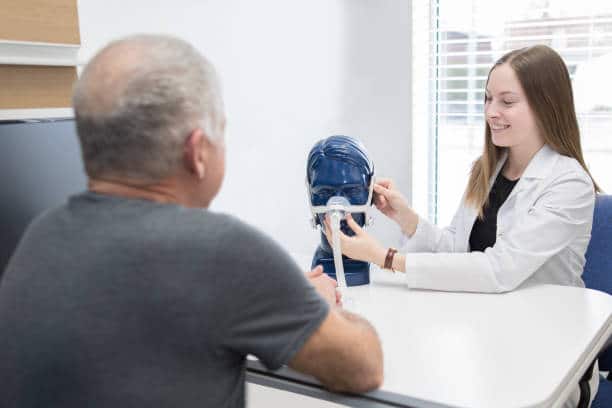If you have CPAP machine troubleshooting, have no fear; you are not alone. CPAP equipment is often used to treat sleep apnea, which may result in daytime drowsiness, poor productivity, and other health difficulties. But, much like any other medical gadget, CPAP devices may malfunction.
This page provides a troubleshooting guide for common CPAP machine problems, including air pressure-related issues, mask-related issues, humidifier-related issues, and travel and battery backup concerns. We at CPAPwater will also highlight the need for preventive maintenance and assist CPAP users with maintenance tips to ensure their equipment continues to perform correctly.
Those with sleep apnea may ensure they get the most effective treatment possible by following the guidelines and tactics outlined in this article.
Understanding the Importance of Proper CPAP Machine Maintenance
Maintaining your continuous positive airway pressure (CPAP) machine is crucial, much like how we look after our vehicles with regular tune-ups. Regular care ensures that the machine works effectively and lasts longer.
Without proper maintenance, its performance can decline, affecting the quality of your sleep. Taking simple preventive measures can help you avoid many common issues and ensure that the machine remains reliable. In short, a well-maintained CPAP machine means better sleep and fewer problems down the line.
Common Issues With CPAP Machines

CPAP devices are very successful in treating sleep apnea, but like any other medical device, they are susceptible to malfunctions that might compromise their efficacy.
These are some of the most typical CPAP machine concerns customers may encounter:
Mask Leakage
Mask leaks occur when air leaks around the mask that attaches to the CPAP machine. This might result in a drop in air pressure, compromising the machine’s efficacy. This may be caused by a poor mask fit, degeneration of the mask cushion, or tubing air leakage.
Dry Mouth
As the air from the machine dries out the mouth and throat, dry mouth may result, which can be painful and impact sleep quality. This may be caused by an improperly fitted mask, low humidity settings on the machine, or mouth breathing.
Nasal Congestion
Nasal congestion occurs when nasal airways become obstructed, causing pain and affecting the machine’s air pressure. This may be brought on by allergies, a deviated septum, the common cold, or influenza.
CPAP Machine Noise
Machine noise may be distracting and diminish sleep quality. This may result from a faulty fan or motor or weak connections inside the machine.
CPAP Machine Troubleshooting Solutions
Here are some troubleshooting techniques for typical CPAP machine issues:
Mask leaks
Mask leaks occur when the mask does not fit correctly, or the tubing has holes. To remedy this problem, the first step is to ensure that the mask is the right size and works well by adjusting its fit. Strap tightening may assist in providing a snug fit without pain or pressure points. If altering the fit does not resolve the issue, the mask cushion should be replaced every three to six months, as the manufacturer indicates.
A worn or torn cushion might inhibit a good seal and produce leakage. Inspecting the tubing for air leaks is also essential since any holes or rips might allow air to escape and create leaks. All broken components should be replaced. Try a new mask type or size if none of these methods work. For instance, a nasal cushion mask may be less obtrusive and give a better fit.
Having A Dry Mouth
A dry mouth is a frequent complaint among CPAP users, which may be caused by mouth breathing or by the machine’s air drying out the mouth and throat. The first step in addressing this condition is to use a heated humidifier, which provides moisture to the air and may prevent dry mouth. To prevent contamination, it is essential that the chamber be filled with distilled water and frequently cleaned.
If mouth breathing causes dry mouth, consider wearing a chin strap to keep the mouth closed while sleeping. The alternative is to wear a full-face mask that covers the mouth and nose, preventing air from escaping via the mouth and drying out the mouth and throat.
Sinus Congestion
Nasal congestion is another frequent concern among CPAP users, and it may be caused by allergens or a deviated septum, among other things. A saline nasal spray, which may help decrease inflammation and congestion in the nasal passages, is the first step in addressing this condition. It is essential to use a spray for nasal passages and follow the directions precisely.
A nasal pillow mask that fits correctly is another option since a good fit may assist in avoiding air leaks and enhancing air pressure. If nasal congestion persists, it is essential to contact a sleep expert, who can decide whether an underlying medical problem must be treated.
Machine Noise
Many issues, such as a broken fan, motor, or weak connections, might create machine noise. The first step in resolving this problem is to inspect the fan and motor for defects. If the noise is very loud or persistent, there may be a problem with the equipment that requires the attention of an expert.
Tightening loose connections is also beneficial, ensuring all components are firmly linked and tightened. The machine may also be placed on a soft surface, such as a towel or foam pad, to lessen vibrations and noise.
Pressure Discomfort
When the pressure settings on the CPAP machine are too high or the mask does not fit correctly, pressure discomfort might develop. The first step in addressing this problem is to alter the pressure settings with the assistance of a sleep expert. The professional is able to assist in determining the optimal pressure setting for the user and adjusting the machine appropriately.
If the mask does not fit correctly, consider trying an alternative mask that fits better since a perfect fit may assist in evenly distributing pressure and preventing pain. Consider the use of a nasal mask, which offers a more direct airflow and may be more pleasant for specific users.
Preventative Maintenance

Preventive maintenance is essential for prolonging the life of your CPAP equipment and avoiding problems during treatment. The following advice can help you maintain your machine’s optimal condition:
Regularly Clean Your Mask And Machine
Regular cleaning of your CPAP mask and machine is essential for keeping a suitable treatment. Bacteria and mold may accumulate over time in the mask, tubing, and water chamber, causing respiratory infections or aggravating existing health problems. Thus, cleaning your mask, tubing, and water chamber at least once a week using mild soap and water is necessary. In addition, specific CPAP devices feature filters that must be frequently updated to provide adequate air filtering.
Replace As Necessary
If required, replacing components helps avoid problems such as mask leakage and discomfort. The mask cushion, headpiece, tubing, and filters are often changeable components of CPAP machines. Following the manufacturer’s CPAP machine replacement recommendations for these components may help avoid possible problems and maintain the efficacy of your CPAP treatment.
Properly Stow Your Equipment
Properly storing your computer is also vital for extending its life. Your CPAP machine should be kept in a dry, cold location and out of direct sunlight. It is essential to avoid keeping the equipment in a dusty environment or near any chemicals that might harm it. Use a carrying case while transporting your machine to prevent damage during transit.
Inspect The Power Supply
Monitoring the power source is essential for ensuring your CPAP machine functions properly. Your machine may malfunction if the power source is improperly connected or the cable is frayed or broken. Potential problems with the CPAP machine’s power source may be avoided by regularly inspecting the power cable for damage and replacing it promptly if you find any.
Common concerns, such as mask leakage, air pressure difficulties, and severe daily drowsiness, may be avoided with preventative maintenance. By periodically cleaning your mask and machine, changing worn components, storing your device appropriately, and inspecting the power supply, you can prolong the life of your CPAP machine and ensure that it performs well throughout treatment. See a sleep professional to alter the advised pressure setting or consider using a different mask or device if you encounter difficulties.
Tips for Troubleshooting and Maintaining Your CPAP Machine
Like any piece of vital equipment, your CPAP machine requires periodic attention to ensure its optimal functioning. Here are ten detailed tips to guide you in maintaining and troubleshooting your machine:
Clean Filters Monthly
Filters are the first line of defense against impurities entering your machine. Over time, they can accumulate dust and debris. A regular cleaning or replacement, ideally once a month, ensures that the airflow remains pure and unhindered. If your environment is particularly dusty, consider cleaning more frequently.
Inspect Tubing for Damage
The tubing is an essential conduit for the air you breathe. Over time, it can develop small cracks and holes or become loose at the connections. Regularly stretch out the tubing and check its length for any visible signs of wear. Addressing these early can prevent bigger issues in the future.
Keep Humidifier Clean
The humidifier chamber is where water is added to the air to prevent dryness. Mineral deposits and other impurities can accumulate if left unchecked. A weekly cleaning, preferably with distilled water, ensures efficient humidification and prevents potential respiratory irritants.
Avoid Blocked Airflow
Your CPAP machine draws in air to regulate and provide therapy. Ensuring this airflow isn’t obstructed is crucial. Place your machine on a flat, stable surface away from curtains or other items that might block the intake, allowing it to breathe freely.
Check Electrical Connections
Electrical connections are vital for powering your machine. Ensure power cords are firmly plugged in, and routinely inspect them for wear, damage, or other issues. A secure and damage-free connection guarantees an uninterrupted power supply.
Regularly Update Your Mask
Materials deteriorate over time, and this applies to your mask as well. An older mask might not provide the same level of comfort or efficiency as when it was new. Consider replacing it every six months to a year, ensuring you always get the best from your CPAP therapy.
Use CPAP-Friendly Cleaning Supplies
Just as you’d choose the right cleaning products for delicate fabrics, pick cleaning supplies specifically designed for CPAP machines. This can help in ensuring the longevity and efficiency of your equipment.
Also Read: Discover The Top 5 CPAP Cleaners And What Sets Them Apart
Store in a Safe Place
Protect your CPAP machine from accidental bumps, spills, or curious pets. Store it in a designated, dry area away from direct sunlight to ensure its longevity when not in use
Mask Cleaning And Maintenance
Appropriate mask cleaning and maintenance are required for CPAP treatment to be successful and to avoid problems such as mask leaks and skin irritation.
Here are some maintenance instructions for your CPAP mask:
Clean Your Mask Daily
CPAP users must clean and maintain their masks properly to ensure their treatment is successful and pleasant. Cleaning the mask and headgear daily with warm, soapy water will help remove oils, perspiration, and grime that can develop on the mask and cause skin irritation and mask leaks. It is vital to avoid using aggressive cleaning agents that might harm the mask’s material. The mask must also be appropriately stored while not in use since exposure to direct sunlight, or humid surroundings may induce mold growth.
Regularly Replace Your Mask’s Components
Replacement of mask components, including the cushion and headgear, as indicated by the manufacturer or healthcare professional, is also essential for preserving the mask’s efficacy and comfort. The cushion and headpiece might lose elasticity and fit over time, resulting in mask leaks and discomfort.
Preserving Your Mask Correctly
While not in use, masks should be stored clean and dry. Mold may form on the mask if it is left in direct sunlight or a moist environment.
Use The Proper Mask For Your Requirements.
It is also essential to choose the ideal mask for your requirements. There are several varieties of CPAP masks, including nasal masks, nasal pillow masks, and full-face masks, and it is essential to choose a mask that fits well and is pleasant to use.
Check For Mask Leakage
Regularly checking for mask leaks by turning on the machine and feeling for any air leakage will assist in discovering fit concerns and enable changes.
Clean The Chamber Of Your Humidifier
To avoid the formation of mold and germs, it is crucial to clean the humidifier chamber if your machine has one. Frequent cleaning with soap and water ensures the chamber is clear of pathogenic microorganisms and maintains the proper humidity levels.
According to these guidelines, you can maintain your CPAP mask and avoid frequent complications that may impede your CPAP treatment.
Humidifier Troubleshooting

Troubleshooting the humidifier is essential to CPAP machine maintenance to guarantee optimal sleep quality. Here are some CPAP Machine troubleshooting and problem-solving suggestions for the humidifier:
Maintain And Clean The Humidifier
It is essential to regularly clean and maintain the humidifier to avoid problems such as leaks and a blocked water chamber. To clean the humidifier, remove the humidifier chamber from the CPAP machine and discard any residual water. Wash the chamber with warm water and mild detergent, rinsing thoroughly and allowing it to dry naturally. Be careful to follow the manufacturer’s cleaning and maintenance guidelines.
Examine For Leaks
Leaks in the humidifier may cause water to build in the CPAP tubing, which can foster mold development and reduce the treatment’s efficacy. Examine the humidifier chamber and tubing for visual evidence of damage or cracks to check for leaks. Immediately replace any broken components found. See your healthcare physician or a sleep expert if the leaks continue.
Determine The Water Level
If you suffer dryness or discomfort during CPAP therapy, inadequate water in the humidifier may be to blame. Regularly check the water level and replenish the humidifier chamber as necessary. You may use the maximum and minimum water level indicators on the majority of humidifiers as a reference.
Change The Relative Humidity
You may encounter pain or other complications if the humidity level is too high or too low. Change the humidity settings on your Continuous Positive Airway Pressure (CPAP) machine according to your particular preferences and your healthcare provider’s or sleep specialist’s advice.
Use Distilled Water
Distilled water in the humidifier may avoid mineral accumulation and other problems. The minerals and other pollutants in tap water might clog the humidifier and reduce its efficacy.
By following these guidelines, you may diagnose and repair difficulties with your CPAP humidifier and enhance your CPAP treatment experience overall. A properly running humidifier may aid in the prevention of dryness, congestion, and other conditions that disrupt sleep and treatment.
Pressure-Related Issues
Those who use CPAP devices to treat sleep apnea often have pressure-related difficulties. These concerns reduce the quality of your sleep and make it difficult to continue using the device.
These are some CPAP Machine troubleshooting and resolution strategies for pressure-related issues:
1. Changing The Pressure Setting
If you have pressure-related difficulties such as pressure ulcers or aerophagia, adjusting the pressure settings on your CPAP machine may be beneficial. Nevertheless, you should only modify your blood pressure settings under the supervision of a medical practitioner. They suggest a different pressure setting that better fits your requirements and ease any pain or problems you may be experiencing.
2. Testing Various Mask Types Or Sizes
Occasionally, pressure-related concerns might be caused by a mask that does not fit properly. Experimenting with several mask shapes and sizes is essential to discover the one that suits you best. This may help your mask seal and apply the right pressure to treat sleep apnea without pain or pressure.
3. Consultation With a Healthcare Professional For Advanced Problem-Solving
Suppose you have tried modifying your pressure settings and using a variety of mask shapes and sizes and still have pressure-related concerns. In that case, it may be time to visit a healthcare professional. They may do extensive troubleshooting to detect any underlying issues causing your pain or pressure-related problems. In addition, they may propose further treatments or therapies to address these problems.
With CPAP treatment, pressure-related concerns might affect sleep quality and comfort. With correct troubleshooting and adjusting, it may enhance your CPAP treatment and overall sleep experience by addressing these concerns.
It is essential to consult with your healthcare physician to ensure that your CPAP therapy is appropriately calibrated and delivers the required pressure and support to treat your sleep apnea while reducing any pain or pressure-related difficulties.
Travel And Battery Backup Issues

Traveling with a CPAP machine can be tough, but proper planning can ensure that your therapy continues during your vacation. Here are some CPAP machine troubleshooting techniques for typical travel issues:
1. Pack Your Machine With Care
Be cautious about packing your CPAP machine properly before traveling to minimize damage. Use a cushioned carrying case or bag for transit protection. Consider packing a surge protector to safeguard your device from power spikes.
2. Know Your Power Alternatives
Battery backup may be necessary if you go to an area without electrical outlets. Ensure you have the correct battery type for your device, and fully charge it before you go. Moreover, you should pack a spare battery just in case.
3. Adapt To Various Time Zones
Traveling across many time zones might make adapting your CPAP therapy routine challenging. A few days before your trip, attempt to gradually adjust your sleep routine to ease the change. You may also modify the time zone on your computer’s internal clock.
4. Prepare For Your Flight
Check with your airline on their CPAP machine rules if you’re flying. The airline may force you to inform them and use a backup battery during the journey. Pack your machine in your carry-on and provide a copy of your prescription.
There are many considerations to bear in mind while employing a battery backup:
5. Choose The Appropriate Battery
Ensure you have the correct battery type for your device. Check the handbook of your CPAP machine to see what sort of batteries it requires.
6. Fully Charge The Battery
Be careful to completely charge your battery before using it. Moreover, you should pack a spare battery just in case.
7. Use The Battery Correctly
Follow the directions provided by the manufacturer when using the battery with your equipment. Ensure the battery is correctly connected and switched on before using the equipment.
Preparing for travel and power interruptions may ensure that CPAP therapy continues uninterrupted. You may prevent typical travel-related concerns by adequately packing your device, understanding your power choices, and adapting to various time zones. And by selecting the appropriate battery, completely charging it, and using it correctly, you can guarantee that your equipment continues to function during power outages.
Also Read: Best Batteries and Battery Backup for CPAP
The Role of Professional Servicing

Much like when a trusty appliance starts to falter, there are moments with your CPAP machine when personal troubleshooting just isn’t enough. Recognizing the signs early can save you a lot of distress and ensure uninterrupted, effective sleep therapy.
Whether it’s consistent unusual noises despite a clean bill of health, electrical hitches, or a nagging sense that the therapy quality has diminished, it might be time to consult a technician. A professional evaluation identifies underlying issues and ensures that your CPAP machine continues to serve you optimally, providing the restful sleep you need.
Frequently Asked Questions
Which type of mask should I use to reduce skin irritation?
Nasal masks and nasal pillows are both popular choices, with many users finding them more comfortable and less likely to cause skin irritation.
How long does it usually take to adjust to using a CPAP machine?
Adjusting to using a CPAP machine can vary among individuals. Some take a few days, while others might need weeks. Regular use and comfort are crucial.
Why do my nasal passages feel dry after using my CPAP machine?
Dry nasal passages can sometimes result from the air pressure or if there’s insufficient humidification. Adjusting moisture levels or opting for a nasal mask or nasal pillow might help.
I find it challenging to fall asleep with my CPAP on. Any suggestions?
It’s not uncommon to face initial hurdles while trying to fall asleep with the CPAP machine running. You might find it helpful to start with a lower air pressure setting and then gradually adjust as you become more accustomed.
Why does my mask seal keep breaking?
The mask seal is crucial for effective sleep apnea treatment. If it keeps breaking, it might be due to the mask’s fit, wear and tear, or how it’s cleaned. Ensure you’re following proper maintenance guidelines and consider consulting with a specialist if the issue persists.
How can I determine the right CPAP pressure for me?
Finding the optimal CPAP pressure is pivotal for effective sleep apnea treatment. This usually requires a sleep study or consultation with a sleep specialist. They will guide you to the appropriate pressure setting based on your specific needs.
My CPAP mask hurts when I wear it. What should I do?
If your CPAP mask hurts, it might not be the right fit for you or could be too tight. Ensure the mask seal is intact, consider trying different mask styles or sizes, and consult with a technician or specialist for recommendations tailored to your face and comfort.
Is the pressurized air from the CPAP machine safe?
Yes, the pressurized air from the CPAP machine is safe and designed specifically for sleep apnea treatment. It helps keep your airways open while you sleep. If you’re experiencing discomfort or side effects, it’s essential to discuss this with a professional to ensure you’re using the machine correctly.
Conclusion
In this article, we have discussed several typical problems and their remedies associated with CPAP therapy, including air pressure-related problems, mask-related problems, humidifier-related problems, and travel and battery backup problems. We have also included advice for diagnosing and addressing these concerns, such as altering pressure settings, attempting other mask designs or sizes, cleaning and maintaining the equipment, and, where necessary, seeing a healthcare physician or sleep expert.
To achieve the best benefit from CPAP therapy, CPAP users must diligently maintain their equipment and resolve any concerns immediately. Following the suggestions and tactics mentioned in this article, people may troubleshoot and repair typical CPAP difficulties and sleep well and undisturbed.
For a wide range of CPAP supplies and further assistance, explore our carefully curated collection to enhance your CPAP experience.



